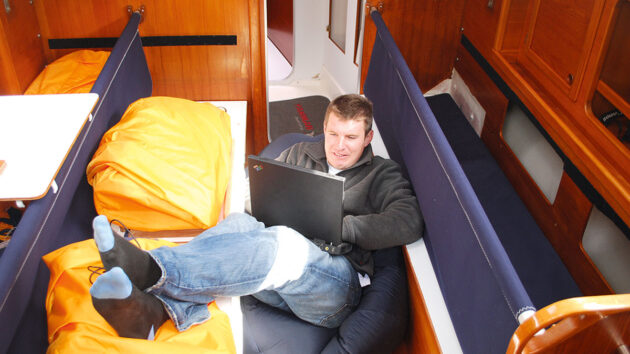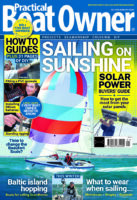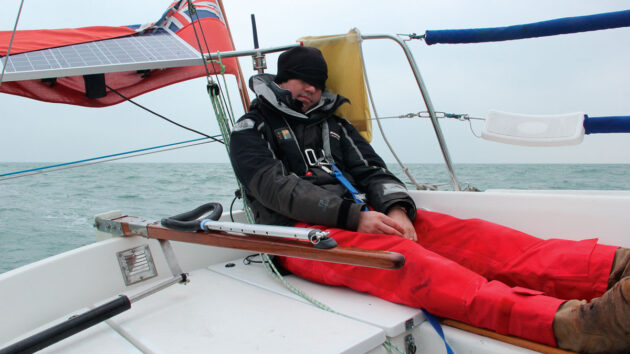John Apps stresses the importance of sleeping sufficiently on long-distance single-handed passages, and explains how to snatch safe naps without leaving yourself vulnerable
Under the International Regulations for the Prevention of Collisions at Sea (IRPCS), all crews are required to keep a watch by sight and sound at all times.
This has caused some controversy among those sailing shorthanded who attempt passages lasting longer than 24 hours, and in some cases passages lasting weeks or months.
Critics of solo sailing argue that it’s simply not possible for a single-handed sailor to comply with this requirement to keep a watch for extended periods.
Sir Francis Chichester used to hoist the two red lights for ‘not under command’ when he wanted to have a sleep.
Other single-handers have heaved to or lay ahull with an anchor light burning. The danger here is the expectation that other vessels will be keeping a good lookout and that they will steer clear of you in those situations.
Attempting to stay awake for long periods can result in your health deteriorating, and in particular, can result in high blood pressure.
More noticeable in the short term is the way your brain may try to deal with the lack of sleep.

A safe place to wedge yourself while navigating or catching up on communications is important when sailing shorthanded
Hallucinations can be very common: for instance, in their night without sleep, single-handed sailors often report the sea appearing to turn to mud, trees growing in the water or coming across a mass of rowing boats in front of them.
One sailor was amused by a television show playing on the inside of his sprayhood windows, while Joshua Slocum famously wrote about the pilot of the Pinta repeatedly steering his boat in bad weather.
The most common hallucinations seem to be hearing voices or radios playing – as reported by Sir Robin Knox-Johnston.
In my experience, hallucinations seem to be confined to the night-time and can be discounted for what they are.
As an example, after a single-handed North Sea crossing, I remember going up the River Crouch with the mudbanks apparently flowing towards my boat like lava.
I knew it was all in my mind, and forced myself to check the depth sounder to ensure that it was not really mud I was sailing through. (Some sailors might argue that much of the East Coast waters are made up of what is, in effect, very thin mud.)
The difficulty is, how do you sleep when there are other vessels about, or when you are dealing with a difficult pilotage requiring constant course corrections?
There are times when it is impossible to leave the cockpit or even to doze off in the cockpit.
Opportunities for sleep whilst sailing shorthanded
In terms of safety, one of the essential tools in a single-hander’s bag is the ability to recognise opportunities when it is possible to sleep.
Depending on your boat speed, it’s generally recognised that 15 minutes is an acceptable length of time to go off watch and get your head down.
In 15 minutes, a sailing boat will travel just over 1NM, and in some cases as much as 2NM.
So, if you are in a large body of water that has no static hazards, from the point of view of hitting a reef or a body of land, you should be safe.
The difficulty, of course, is other vessels. As a sailing boat, there are other vessels that you must give way to, while remaining aware that not all vessels that are required to give way to you will do so.

A bed in the cockpit, on the lee side for comfort whilst sailing shorthanded
A ship travelling at 20 knots and a yacht travelling at 5 knots in a 15-minute period could have a closing distance of over 5NM in that time.
The question that arises is, can you see a ship at five miles away?
In my personal experience, this is generally the case at night, but not always the case during the day.
Fortunately, the faster ships in busy areas tend to use main traffic lanes, and in that respect can be predictably avoided.
One area where I will often take the opportunity to have a 15-minute nap is when crossing Lyme Bay between Start Point and Portland Bill.
In the middle of the night, there are relatively few fishing boats around: all the big ships are out in the middle of the Channel, and the coasters using the inshore traffic zone tend to have arrived or not left.
Depending on the tide, it can take you up to 8 hours to cross Lyme Bay: this will allow quite a few 15-minute naps once you are well away from land and can sight no other vessels.
However, in contrast, crossing the Thames Estuary requires constant vigilance due to both the shifting sandbanks and the 24-hour traffic.
I’ve found that I can easily go for three days with 10 15-minute naps in a 24-hour period.
In many ways, 10 15-minute sleeps can feel just as refreshing as spending a whole night asleep.

John Apps’ UFO27 Glayva being overtaken by a container ship
However, it can be quite hard to judge whether one is actually sleeping for 15 minutes or lying awake trying to get to sleep.
When the alarm goes off before I expect it to – that is, if I am not tossing and turning, waiting for the alarm – I consider I have been asleep.
The important thing is not to worry if you don’t get to sleep in the 15-minute period; even lying down for a quarter of an hour is enormously refreshing when sailing shorthanded.
When I first started sailing shorthanded for long distances, I used to use a thin waterproof camping mattress in the cockpit for my 15-minute naps, believing that it was somewhat safer to be in the cockpit asleep than down below.
I now believe that getting up from my berth and climbing into the cockpit means that I take greater care in having a good look than when just raising my head if lying in the cockpit and having a look around.
Most long-distance single-handers use a kitchen timer or multiple kitchen timers to wake them up at whatever period they desire.
There are certain advantages in mechanical kitchen timers – the type you twist around to give you the desired time interval.
For instance, a traditional mechanical kitchen timer on a quarter turn (90°) is set for the recommended 15 minutes. This requires little thought, and it is more difficult to make a mistake with the time interval.
A tired person setting an electronic kitchen timer or even their phone could make a mistake and set some other time duration without being fully aware of it.
The question that next arises, on a voyage lasting weeks or months, is: can you sleep for longer than 15 minutes at a time?
Every solo sailor will have to make their own judgement about the risks of sleeping for longer periods than you can see something on the horizon.
There are aids, of course, such as radar and AIS, that can help you see beyond the horizon; but both have limitations.
Radar whilst sailing shorthanded
Radar is good in that it shows the demands of a radar system. land and vessels that cast a suitable radar reflection.
Not all vessels have sufficient metal to constitute a good radar target. GRP yachts are notoriously bad, although most attempt to enhance their radar signature with a radar reflector.
Radar can also have limited visibility during rainstorms as it reflects the rain rather well, and in so doing, may obscure a more dangerous target.
But for the things that single-handed sailors really worry about, like ships and fishing vessels, it is extremely useful.
Not all long-distance sailing vessels, however, can produce sufficient electricity to keep up with the high demands of a radar system.
AIS
An Automatic Identification System (AIS) is required on all ships. Most smaller commercial vessels, such as fishing boats, use an AIS transponder, and it seems rare these days for an ocean-going yacht not to have a transponder too.
However, it can be argued that a single-hander is safer with just a receiver than a transponder: this means that he or she will not be reliant upon someone else being aware of their signal.
Having just a receiver forces you to check for yourself what other vessels are in whichever proximity you consider safe.
I have an AIS receiver built into my VHF radio, and will generally turn on the radio every two hours if there are no targets within 50NM of me.
As my VHF radio and AIS share an antenna at the top of the mast, I find it quite common to receive AIS targets at considerably more than 300NM.
In very remote parts of the ocean, when I’ve not seen another vessel for weeks and have no targets on the AIS, I will let my AIS check go out beyond two hours.
On a single-handed voyage of 2,500NM from Easter Island to Tahiti, I saw no other vessels either visually or on the AIS, other than a small cargo ship anchored off Easter Island and a ferry from Moorea to Tahiti as I stood off Papeete at night waiting for dawn to go in through the reef.
…and finally
Keeping a good lookout by sight and sound is critical to making a safe voyage: just as critical is being rested and refreshed to handle the challenges that will occur.
The single-handed sailor has to sleep if making a voyage over 30 hours, and each individual is responsible for finding the correct balance between sleep and watchfulness.
Shipping lanes and pilot charts
When sailing shorthanded across oceans, pilot charts are a very useful aid, although I find them next to useless in determining what weather you are likely to encounter on a voyage.
The information on ocean currents is beneficial, particularly when you feel your log and GPS speed are significantly different.
I print on A3 paper at least one pilot chart for each ocean I intend visiting to assist in making out the detail.
Some shipping routes are fairly obvious. Coming out of the English Channel, you’d expect a large number of ships to be heading towards North America.
However, one that can catch you out is the large number of ships heading for the Mona Passage between the Dominican Republic and Puerto Rico on their way to the Panama Canal.
I was surprised at the amount of shipping in the 1,000 miles between north-east Brazil and West Africa, but when you consider that traffic can be heading in eight different directions at that point, it stands to reason, particularly with the large number of vessels avoiding the Suez Canal by rounding the Cape of Good Hope.
Can you ever relax when sailing shorthanded? You probably can, but I have been caught out on a number of occasions
. Once, a couple of hundred miles north-east of Newfoundland, I got up before dawn to fill in my log at 0600 UTC. I wasn’t expecting there to be any traffic around, but I went on deck anyway to carry out a visual check.
It was blowing about Force 7, and I was dealing with 6m waves with a 100m interval that severely restricted my view in the troughs.
As I came on deck and mounted the crest of one of the swells, I saw a Russian factory fishing ship directly in front of me on the next crest with all lights blazing.
I was too stunned to go and disengage my Windpilot and sheer off: fortunately, the fishing ship was more awake than I was, and as we passed on the next crest, he was 100m off my starboard beam.
collection name=small]
Want to read more seamanship articles like How to sleep sailing shorthanded?

A subscription to Practical Boat Owner magazine costs around 40% less than the cover price.
Print and digital editions are available through Magazines Direct – where you can also find the latest deals.
PBO is packed with information to help you get the most from boat ownership – whether sail or power.
-
-
-
- Take your DIY skills to the next level with trusted advice on boat maintenance and repairs
- Impartial, in-depth gear reviews
- Practical cruising tips for making the most of your time afloat
-
-
Follow us on Facebook, Instagram, TikTok and Twitter




